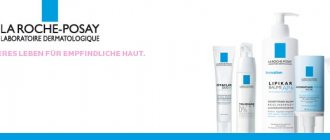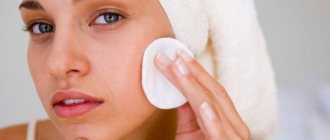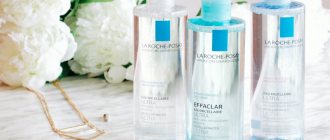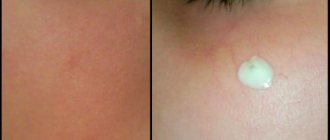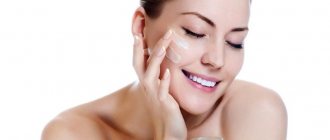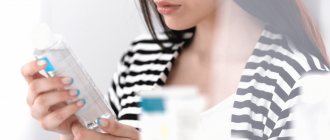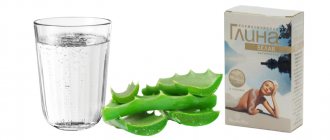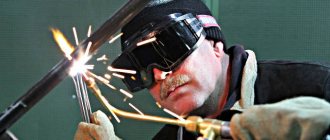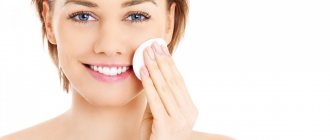La Roche-Posay is a French cosmetic brand - a pharmaceutical line of drugs owned by the largest cosmetic concern L'OREAL.
All cosmetic products contain thermal water, which the company considers unique in its effectiveness when applied to the skin.
Here's what they write about it on the official website of La Roche-Posay:
In the very center of one of the French villages there is a thermal spring, the water of which has a healing effect on the skin. La Roche-Posay is a small village located in the center of the French region of Vienne. The village owes its world fame to the water of the spring located there, which has a particularly beneficial effect on the skin due to its high selenium content.
Already by 1617, the healing properties of La Roche-Posay thermal water were so well known that Pierre Milon, physician to Henry IV and Louis XIII, went to the source to conduct the first studies. Napoleon, then simply General Bonaparte, returning from the Egyptian campaign at the beginning of the 19th century, ordered the construction of a hospital at the spring to treat his soldiers for skin diseases. In 1897, this place received official recognition from the French Academy of Medicine. The first thermal center opened in 1905, and in 1913 the French Academy of Medicine awarded La Roche-Posay official spa resort status.
Sounds familiar, doesn't it? The L'OREAL concern also owns the Biotherm cosmetics brand, and the healing properties of the “unique” Biotherm thermal water are also advertised there. And, of course, we encountered no less “unique” thermal waters from both the Uriage and Avene companies.
Meanwhile, our skin absolutely does not care from which thermal source the water is used to make cosmetics, water is water.
And how much mineral substances from water are absorbed into the skin is not yet known for certain to science. There is an opinion that mineral elements are not absorbed from water at all. In any case, for the health and beauty of our skin we need much more than just water.
La Roche-Posay thermal water is rich in selenium. It is a well-known antioxidant. But all its beneficial properties have been scientifically proven only when taken orally, and not when applied to the skin.
According to scientific research, selenium exhibits its antioxidant properties and is active when applied to the skin only if it is present in a cosmetic preparation in the form of the compound selenomethionine (source: Journal of Cosmetic Dermatology, July 2004, pp. 149–155).
And La Roche-Posay thermal water simply contains selenium, so it cannot be reliably stated that it is particularly beneficial for our skin.
And, of course, treating dermatological diseases only with the help of LaRoche-Posay cosmetics will not work at all - it does not contain active medicinal ingredients. All “pharmacy” cosmetics can only be used as an addition to doctor’s prescriptions.
Care for sensitive skin with prebiotic formula Toleriane Sensitive Crème
This is the first La Roche-Posay treatment for sensitive skin with a prebiotic formula.
This product has an incredibly light texture that is quickly absorbed and does not leave behind an unpleasant sticky film. The cream moisturizes the skin and also reduces signs of hypersensitivity: soothes, removes the feeling of tightness, restoring a feeling of total comfort.
Expert opinion
Alexander Prokofiev, dermatovenerologist and medical expert of the La Roche-Posay brand “The prebiotic formula regulates the skin microbiome (this is a collection of billions of bacteria living on the surface of the skin) and strengthens its natural protective barrier: the skin loses less moisture and is better protected from the effects of aggressive external factors environment: wind, polluted and (or) dry air, temperature changes.”
First La Roche Posay cosmetics
The company presented its first line of cosmetics in 1989. Less than a year has passed since the world's largest holding company for the production of cosmetics, L'Oreal, invited La Roche Posey to join them.
The products of this brand are very diverse . Highly effective products of different lines are presented on the market:
- Facial skin care.
- Body care cosmetics.
- Line of cosmetics for children.
- Hair care products.
- Line of decorative cosmetics.
- A line aimed at combating skin aging.
All products of this brand undergo thorough clinical studies involving people with sensitive skin, which is why they have earned the trust of cosmetologists and dermatologists around the world. The effectiveness of La Roche Posay cosmetics lies in the consistency of its components, which help maintain the physiological balance of the skin.
Corrective cream-gel for oily acne-prone skin Effaclar Duo+
This product copes well with imperfections, blackheads, clogged pores and post-acne.
This is one of the few remedies that reduces pronounced imperfections and prevents their re-formation. Its work becomes noticeable within 12 hours after application. In addition to its direct duties, the cream-gel removes oily shine and can be used as a base for makeup.
Expert opinion
Alexander Prokofiev, dermatovenereologist and medical expert of the La Roche-Posay brand “A comprehensive product for the care of problem skin that affects imperfections at every stage of their development and regulates the microbiome of acne-prone skin.”
History of the brand name
According to legend, the source of La Roche Posey was discovered in the 14th century by the French nobleman Bertrand du Guesclin. Stopping by the water to quench his thirst and rest, he noticed that his favorite horse, which suffered from severe eczema , entered the water, and after bathing the eczema went away .
From that time on, people all over France began to talk about this source, and finally, in the 17th century, the court physician of King Henry IV, Pierre Milon, went to study it. After the first analysis, it became clear that this was thermal water enriched with selenium. Scientists later found out that this water is formed after rainwater is filtered by a thick layer of chalk rock and selenium deposits. The mineral salts and trace elements contained in the water make it a unique remedy with an antioxidant and calming effect.
At the beginning of the 19th century , after returning from Egypt, Napoleon Bonaparte ordered the construction of a hospital in La Roche Posey to treat skin diseases among soldiers. And in 1905, a few years after the spring was officially recognized as curative by the French Academy of Medicine, the first balneological thermal center was opened to treat skin problems, mainly psoriasis and eczema. About 10 thousand people are treated here every year.
Only 70 years later, the pharmaceutical company La Roche Posay appeared, naming its brand after the famous spring, the thermal waters of which were used in the development of cosmetic products.
Micellar water for sensitive and allergy-prone skin Ultra
Removes makeup from the face and skin around the eyes without using water and at the same time moisturizes and reduces redness.
In this “water” you will not find fragrances, dyes, alcohol or oils. Even those who wear contact lenses can use this micellar water - there will definitely be no red-eye effect. But the make-up and any contaminants from the surface of the skin will be captured and neutralized by “special agents”.
Expert opinion
Alexander Prokofiev, dermatovenerologist and medical expert of the La Roche-Posay brand “The architecture of the micellar water formula, developed by the La Roche-Posay dermatological laboratory, allowed us to combine the power of micelles and glycerin to achieve optimal effectiveness and tolerability.”
Hydreane
The purpose of this range is not only to moisturize, but also to reduce skin sensitivity. Its popularity among consumers is due to the presence of hydrolipids and many mineral substances necessary for the epidermis.
So, the line includes the following products:
- Hydreane Legere is a cream with pigments of natural origin that can even out the tone. The non-greasy and very delicate texture caused a real stir among dermatologists. It is not surprising that it was noted as one of the best cosmetics.
- Extra Riche is an extra-moisturizing emulsion rich in magnesium, selenium and hydrolipids. Experts recommend using a moisture-forming cream-lezher every day and after just 4 weeks, skin sensitivity will noticeably decrease and the condition will improve by 80%.
- The latest representative of the line is BB-Cream, which is presented in two shades: natural beige and light.
All 4 products in the Hydreane range are tested and have a quality certificate. In addition, laboratory studies and testing have proven that the products have shown their effectiveness even when other similar drugs could not cope with the problem.
Roche Corporation is getting rich on “killer drugs” against COVID-19. Russia turned out to be smarter
On March 30, the head of the Federal Medical and Biological Agency, Veronika Skvortsova, said that the hospital in Kommunarka could soon receive the drug Mefloquine, which is being studied for its effectiveness in the fight against coronavirus. Critics are already accusing the Ministry of Health of allowing a toxic drug from the Swiss corporation Hoffman-La Roche, which has enriched itself from swine flu and is taking over the markets of other countries amid the COVID-19 pandemic, onto the Russian market.
In different countries, there is more and more talk about the need to create both a vaccine against coronavirus and the development of drugs that can stop severe complications. The advantage of such medications is not at all that they will help you not get infected, but that if this happens, the disease will be mild or the chances of developing complications will become significantly less.
Oddly enough, modern high-tech medicine in developed countries cannot offer anything other than symptomatic treatment to combat coronavirus. That is why the struggle on the market of antiviral drugs with unproven effectiveness against COVID-19 is now intensifying.
In past years, the “miracle pill,” for example, turned out to be the drug Tamiflu (“Oseltamivir”), which was used in the fight against swine flu and was promoted throughout the world. This PR pursued the understandable business interests of two players: the American biotechnology company Gilead Sciences and the manufacturer of Tamiflu, the Swiss pharmaceutical giant Hoffman - La Roche. Once doctors accepted that the drug was effective, Tamiflu captured global markets. It even came to the point of purchasing batches for the state reserve by different countries.
However, now it is not swine flu that continues to sweep across the planet, but the coronavirus COVID-19. And although there are opinions in the United States that Tamiflu can alleviate symptoms and the general course of the disease, there is no real evidence of the effectiveness of this drug in the fight against coronavirus.
In past years, the “miracle pill,” for example, turned out to be the drug Tamiflu (“Oseltamivir”), which was used in the fight against swine flu and was promoted throughout the world. Photo: AGN “Moscow”
Meanwhile, the corporation still found a way out of the situation. She put on the market the long-forgotten anti-malarial drug Mefloquine, which may be effective against coronavirus. The same “Mefloquine” that a number of doctors and pharmacists call the “killer drug” because of its extreme toxicity. It is obvious that Roche wants to repeat the success of past years, but many were surprised by the first reports that Russia would also begin to use this drug. How dangerous is this and are we not following the lead of international corporations?
Foul play
The Hoffman-La Roche company became famous not only for its dangerous drugs, but also for its methods of waging wars of destruction on the pharmaceutical market. Roche has been and continues to be sued by many companies in different countries. In 2011, the Chinese state newspaper Southern Metropolis Daily accused the Swiss company of inciting panic in China in order to sell the Chinese a miracle drug against an unknown virus. Note that at that time, only two years had passed since the outbreak of swine flu A/H1N1, and the Chinese were still frightened by the pandemic.
Roche held a press conference in Guangzhou, which has been declared the epicenter of a new flu similar to the bird flu that hit Hong Kong in 1997. Rumors about the risk of a new epidemic quickly spread, and demand for the much-touted drug soared.
How Roche is capturing foreign markets is clearly illustrated by the example of Ukraine, which purchased record quantities of Tamiflu in 2009 to combat swine flu A/H1N1. As Ukrainian media reported at the time, the World Health Organization (WHO) recommended that Ukraine, when identifying the first case of swine flu, use medications from the protocol for this disease. One of them is Tamiflu.
As a result, Ukraine initially bought 300 thousand doses of this medicine from Roche and announced its intention to purchase another 700 thousand doses. At the same time, Roche gave Ukrainians a discount by selling the drug for 67 hryvnia per pack, while in Europe Tamiflu cost $31 per pack (248 hryvnia at that time). However, only Roche itself, the Ukrainian authorities and pharmacies benefited from the deal, because the retail price of the medicine immediately soared to 350 hryvnia, according to media reports that spoke with pharmacy chains at the time.
The Russian pharmaceutical company BIOCAD, which is a competitor of the Swiss in the production of anti-cancer drugs, is suing Roche. In April 2022, the Swiss publication Handelszeitung wrote about the composition of BIOCAD's claims against Roche in a New York court. From the court case data obtained by the newspaper, it follows that the Swiss company has launched a war in Russia to destroy any national competitor. Bribes, kickbacks, lobbying of interests and even dumping were used.
BIOCAD noted that Roche had built a system of kickbacks in Russia, and the Russian representative office of the company put pressure on employees, which even led to cases of suicide. In the hands of BIOCAD were documents that indicated illegal activities in Russia. For example, the company's head office in Basel was aware of the fraud, but even encouraged it.
Roche employees received 10 francs for each pack of Roche drug sold in Russia. Managers entered into an agreement with doctors and at the end of the month they collected empty packs of sold drugs from them, counted the amount and transferred it directly to the doctors, the Russian company said.
In addition, in 2022, in St. Petersburg, a former Roche-Moscow employee who was involved in the shadow sale of the anti-cancer drug Rituximab received a suspended sentence.
What is Mefloquine?
When people in Russia started talking about the possible effectiveness of the antimalarial drug Mefloquine in the fight against coronavirus, the public was hostile to this. After all, the medicine is produced by Roche, and is also extremely toxic. Another group of commentators openly ridiculed the Ministry of Health for “inventing a cure for coronavirus” when it does not exist in the world. Jokes began to be heard about how Russian doctors would now save the world with a Swiss highly toxic drug. Is Mefloquine dangerous and what kind of medicine is it?
Mefloquine (lat. Mefloquinum) was developed for the needs of the US Army in the 1970s. As a drug available for mass use, it entered the market in the 1980s. Mefloquine itself and its derivative Lariam are used to prevent and treat mild and moderate forms of malaria caused by strains of Plasmodium falciparum resistant to chloroquine and other drugs. The drug is also used to prevent malaria. Mefloquine is included by the WHO in the list of vital and essential drugs (VED).
Roche initially tested Mefloquine on monkeys in Guinea, and when Flavoin, which was dangerous due to fatal liver damage, began to be withdrawn from sale throughout Europe, the corporation quickly brought its anti-malaria drug to market.
She brought them out, but did not protect people. In addition to the usual side effects for antimalarial drugs in the form of nausea, vomiting, diarrhea, headache, patients experienced damage to the nervous system, circulatory system, and articulation disorders. Let us recall that it was Roche that became famous for the production of Valium (Diazepam) and the tranquilizers Librium (Chlordiazepoxide), Mogadon (Nitrazepam), which could turn a person into a “vegetable” and were addictive, that is, they provided The company constantly markets for addicted patients.
The struggle on the market for antiviral drugs with unproven effectiveness against COVID-19 is now intensifying. Photo: Andrey Nikerichev/AGN “Moscow”
As for Mefloquine, in 2004, 450 patients in the UK immediately flooded Roche with lawsuits for compensation for irreparable harm to health after taking this drug. The company needed to find new markets.
By a strange coincidence, Roche achieved the appearance of Mefloquine in Russia in the same 2004. Before this, this drug had never been on any list in Russia. However, then, for unknown reasons, “Mefloquine” appeared in the “List of Vital and Essential Medicines,” which was approved by decree of the Russian government on October 21, 2004 No. 1344-r. According to the text of the Cabinet decree, all pharmacies and medical institutions must be fully supplied with Mefloquine.
Will they give us poison?
According to the head of the Federal Medical and Biological Agency (FMBA) Veronika Skvortsova, Mefloquine has a very pronounced anti-coronavirus effect, so it was decided to supply it to the hospital in Kommunarka for the treatment of patients with coronavirus. After everything we know about Mefloquine, this sounds like madness. However, it is not.
Skvortsova said that patients in Kommunarka will not be faced with exactly the same Mefloquine that Roche has been poisoning the United States and Europe with for decades. The work on the drug administration system was carried out in Russia by a research and production company, which developed a treatment regimen for the new coronavirus, taking into account the experience of China and France. An important point is that treatment is not with Mefloquine itself, but based on this drug with the use of others.
Mefloquine and hydrochloride are analogues of the designated quinine drugs against malaria, but with significantly less toxicity, easily tolerated and with a very pronounced anti-coronavirus effect, that is, already in microconcentrations (10 mmol per liter), this drug causes complete inhibition of cytopathic effects in tissue culture,
– Skvortsova said on March 30 (quote from TASS).
COVID-19 quickly causes a powerful immune response in the patient’s body, an inflammatory reaction begins, while the immunosuppressive effect of Mefloquine blocks this response.
Skvortsova reported that “the addition of macrolide antibiotics and synthetic penicillins prevents the development of secondary bacterial-viral syndrome, and also does not allow increasing the concentration of the antiviral agent in the blood plasma and lungs,” thereby reducing the toxicity of the drug.
It was decided to supply Mefloquine to the hospital in Kommunarka for the treatment of patients with coronavirus. Photo: Sofya Sandurskaya/AGN “Moscow”
According to her, FMBA is ready to donate about 3 thousand packages of this medicine to the hospital in Kommunarka. FMBA will also conduct clinical studies to understand whether Mefloquine can be used prophylactically. Thus, Russian pharmacists were able to take the best from a serious drug and develop a system for its safe administration. Therefore, those who say that doctors will start giving patients “poison” are wrong, just as those who talk about the full-fledged invention of their own drug that defeats coronavirus are wrong.
There is no vaccine for COVID-19 yet. But doctors all over the world are trying to reduce the impact of coronavirus on the body and prevent the disease from becoming severe. And while the United States is trying to treat patients with Tamiflu, and Donald Trump has already promoted hydroxychloroquine with careless advice, which led to casualties, Russian doctors and pharmacists certainly did not sit idly by.

